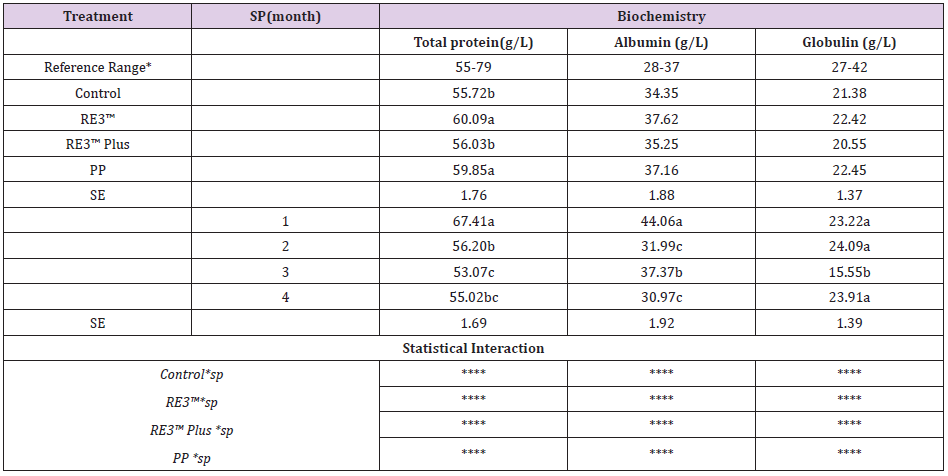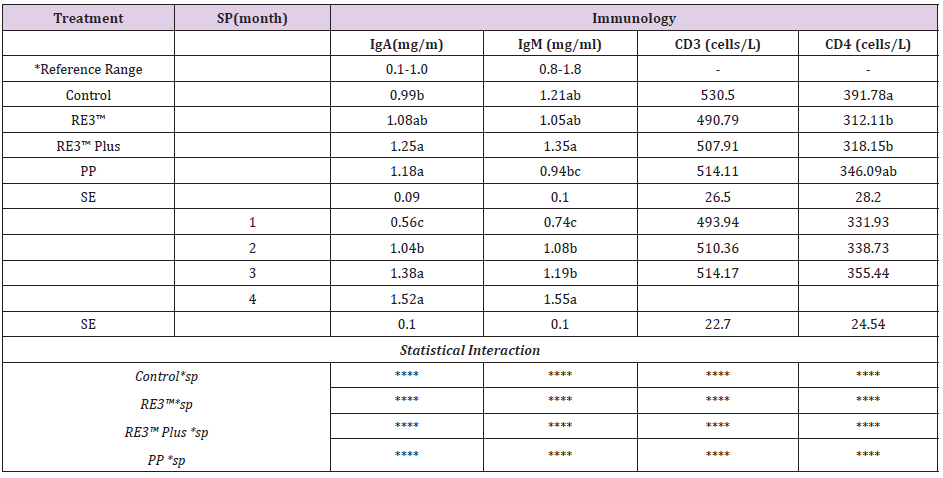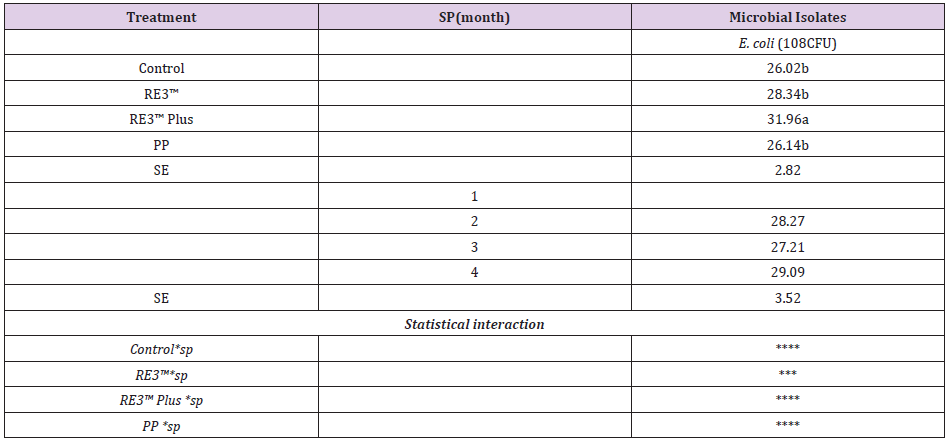Abstract
A 4 mo study investigated the effect of direct fed microbials (DFM): Rumen Enhancer three RE3™, RE3™Plus and Paenibacillus polymyxa (PP) on blood biochemistry, immunological responses and gastrointestinal microbial isolates of neonatal lambs at four phases of growth. Twenty-four lambs of average weight 2.5±1.2Kg were put on four dietary treatments, namely: Control, RE3™, RE3™Plus and PP in a randomized complete block design. Treatments were administered orally during the suckling phase; and were added to their diets after they were weaned. Blood and fecal sampling were done every four weeks till the sixteenth week. The concentrations of total protein, albumen, globulins, IgA, IgM, CD3 and CD4 were assayed in the serum and E. coli counts from the fecal matter. Data recorded was analyzed using the Statistical Analysis System (SAS). Monthly sampling of blood samples for examination showed a significant increase (P<0.05) in total protein when the lambs when RE3 and PP were offered to the lambs, and a non-significant effect on albumin and globulin. Significant differences were registered among the treatments for all immunological parameters measured, except CD3. The study revealed a significant treatment × sampling period interaction (P < 0.0001) for all the parameters measured. The addition of different DFM products generally influenced the blood biochemistry, microbial isolates and immunology of growing lambs.
Keywords: Direct Fed Microbial; Immunology; Lambs; Blood Sample
Introduction
Both beneficial and potentially pathogenic bacteria coexist in the gastrointestinal tract of humans Andrews [1] as well as livestock. However, some routine production practices including weaning, transporting and handling of livestock are stressful conditions that can tip the balance in favour of pathogenic bacteria, thereby compromising the health and productivity of the animal. Neonates are especially vulnerable because both their innate and adaptive immunological responses are either not fully developed or highly suppressed putting them in a state of physiological immunodeficiency Yu et al. [2] Many of the infections acquired by neonates are therefore caused by low virulence organisms including strains of Staphylococcus and Pseudomonas. Antibiotics are commonly used by producers in an attempt to reduce or alleviate disease that may arise because of the above conditions. However, the growing public concern over the widespread use of antibiotics in livestock production and drug residues in animal products has renewed research to seek alternatives to prophylactic use of antibiotics and growth promoters in animal production.
Among the promising alternatives are direct-fed microbial (DFM) which not only improve growth rate and feed efficiency in livestock McAllister et al. [3] but also have direct antagonistic effects on some groups of pathogenic organisms Bach et al. [4]. DFM, also referred to as probiotics, are live naturally occurring microbial supplements which when administered in adequate amounts confer, inter alia, a health benefit on the host. There are indications that DFM prevent or alleviate gastrointestinal disorders and influence some blood variables and growth performance of both monogastrics and ruminants. Studies by Haghighi et al. [5,6] on the use of probiotics revealed an increased serum concentration of IgA, IgG and IgM and intestinal concentration of IgG and IgM in poultry and swine respectively. However, little studies have been done on the effect of DFM on the immune responses in ruminant livestock. The objective of this study therefore was to determine the effects RE3™, RE3 Plus (fermentation products of RE3™) and Paenibacillus polymyxa on the blood chemistry, immunological responses and Escherichia coli counts of lambs.
Materials and Methods
Details of duration, location of study and design of experiment are published in Antwi et al. [7]
Care and Use of Animals
Experimental procedure performed in this study were carried out in accordance with the approved protocol for animal experiment issued by the Animal Ethics Committee of Kwame Nkrumah University of Science and Technology.
Animals and Experimental Design
The study involved a twenty-four 4-day old lambs with an average weight of 2.5 ± 1.2kg were randomly allotted to four dietary treatments (Table 1) and replicated six times in a randomized complete block design.
Derived from Antwi et al. [7]
Table 1: Pre- and post-weaning dietary treatments for pre- and post-weaning phases.
1RE3™ - Rumen Enhancer contains 99% water, Lactobacillus sp., Bacillus sp. and Saccharomyces cerevisiae. 2RE3™Plus is a fermented product of RE3™ 3DFM product containing Paenibacillus polymyxa ** DFM products were manufactured by BEST Environmental Technology Inc. Canada.
Blood Sampling, Biochemistry and Immunohistochemistry
Five milliliters (5mls) of blood sample was collected from the lambs into anticoagulant tube as well serum gel separator tube (SST). The blood samples in SST were centrifuge at 1500 rpm for 3 minutes. The serum was collected and stored in cryovals at -80 °C pending analysis. Total protein, albumin and globulin were measured by Cobas Integra 400 plus automated chemistry. For serum immunoglobulins, blood samples were analyzed for the concentrations of IgA and IgM by solid phase sandwich ELISA using the DuoSet ELISA kit (R&D Systems, Inc., USA). The CD3 and CD4 were measured using BD FACS count analyzer according to the manufacturer’s instructions.
Microbial Enumeration
Fecal samples were collected from the lambs for E. coli enumeration. Samples were cultured in CLED media and tested by gram stain, and biochemically by indole rest, and triple sugar test.
Statistical Analysis
The PROC MIXED procedure of Statistical Analytical System (SAS, 1998) was used to analyze all the experimental data. Where there was significant effect at (P<0.05) treatment means were compared by least square means. The mean separation was tested by Waller Duncan Multiple Range test in SAS.
Results Discussion
Overview
A batch of the blood sampled at the start of the experiment clotted so CD3 and CD4 cells’ data for the first month could not be determined. The fecal sample for the neonates could not be collected before the start of the experiment with the reason being that the rectal insertion by the veterinarian to grab fecal samples was not successful, so baseline assessment of the microbial isolates was not obtained.
Direct Fed Microbial Effect on Blood Biochemistry
Total protein, albumin and globulin contents being the indicators of protein metabolism in the animal are presented Table 2. Significant interaction (P< 0.0001) existed between treatments and period of sampling for the blood biochemistry profiles. There was a significant increase (P=0.0161) in the total blood protein for lambs on RE3™and PP than those on RE3™ Plus and control. This contrasts the observation by Abas et al. [8] who reported an increased level of total protein in a control diet than a DFM treated diet. Though the albumin and the globulin levels were similar (P = 0.3074; P= 0.4752) among the treatments indicating that nitrogen metabolism was not affected by DFM supplementation Jouany et al. [9], it contrasts the study by Dabiri et al. [10] who reported a significant difference in albumin level in suckling lambs when DFM was added to the diet of lactating ewes. Besides, the authors in the same studies recorded no significant difference in total protein and globulin, the levels reported however, were relatively higher than values recorded in this study. The parameters (total protein, albumin and globulin) measured was significantly influenced (P < 0.05) by the period they were sampled. The levels of all the measured parameters were high during the first two months except albumin levels which declined significantly (Table 2). The total protein recorded a dip in the third month and latter increased at the last month of sampling. This observation contrasts the study by Siv et al. [11] who reported a steadily increase in total protein with advancing age of sheep. Though the authors of the same study recorded a decrease and a subsequent increase in globulin levels in a similar fashion as the measured total protein in this trial, the levels reported for the globulin did not follow a similar pattern as the other two parameters.
Table 2: Direct fed microbial effect on blood biochemistry.
Means with the common letter within treatment and sampling periods (SP) are not significantly different based on comparison of least squares means within PROC MIXED of SAS. **** P < 0. 0001.Where RE3™ = fermentation products of RE3™, PP = Paenibacillus polymyxa; SE = standard error. *Borjesson et al. (2000)
Direct Fed Microbial Effect on Immunology
The lambs on RE3™ Plus and PP recorded the highest (P= 0.0122) IgA levels compared to those on Control but the values were however similar to those for lambs on RE3™ (P=0.1197) (Table 3). Similarities in the levels of the IgM were observed in control, RE3™ and RE3™ Plus. The difference between PP and the control however tended to approach significance (P=0.0077). There were no significant differences (P=0.555) among the treatments in the levels of CD3 cells. The CD4 levels on the other hand differed significantly (P=0.0316) among the treatments. The ingestion of DFM elicited a significant (P<0.05) IgA response as compared to the control, with the exception of RE3™ which educed similar response as the control diet. IgA according to Woof and Kerr [12], is a major serum immunoglobulin that bathes the mucosal surfaces and act as an important first line of defense. The relatively higher levels of IgA secreted by the mucosal system among the treatments than the control may be as a result of the immune response to neutralize the micro-organisms (DFM) which may be perceived as foreign bodies or toxins.
Table 3: Direct fed microbial effect on immunology.
Means with the common letter within treatment and sampling periods (SP) are not significantly different based on comparison of least squares means within PROC MIXED of SAS. **** P < 0. 0001.Where RE3™ = fermentation products of RE3™, PP = Paenibacillus polymyxa; SE = standard error; IgA= immunoglobin A; IgM= immunoglobin M; CD3= cluster of differentiation 3; CD4= cluster of differentiation 4;
Similar responses of IgM, produced by the glandular cells and being the first antibodies to be produced in the body in response to infection, were recorded for the control, RE3™, RE3™ Plus treatments except for PP which elicited a significantly lower (P<0.05) IgM response but comparable to the control and RE3™ influence on IgM. No significant differences (P>0.05) existed among the CD3 responses to the DFM treatments. The number of leucocytes expressing CD4 was lower (P<0.05) in the serum of lambs administered the DFM except PP which had a similar CD4 response as the control. This contrast a study by Gebert et al. [13] who reported no significant effect on the number of leukocytes expressing CD8 or CD25 when DFM was fed to pigs. Sampling period significantly influenced (P<0.05) the levels of all measured parameters but no differences (P>0.05) were observed in the levels of CD3 and CD4 with advancing months of sampling. The increase in the levels of IgA and IgM with advancing months of sampling collaborates with a study by Klobasa and Werhahn [14] who reported a rise in serum immunoglobulin concentration after the lambs were weaned. Significant interaction (P< 0.0001) also existed between treatments and period of sampling for the immunological parameters measured.
Direct Fed Microbial Effect on Microbial Isolates
The lambs administered the RE3™ Plus recorded the highest E. coli counts (P=0.0536) compared to unsuplemented lambs, RE3™ and PP (Table 4). No significant differences (P=0.5466) in E. coli counts were found among the control, RE3™and PP. Sampling period (SP) however significantly influenced (P < 0.05) the E. coli counts E. coli are opportunistic pathogens that can cause disease depending upon increased populations and may compromise immune defenses and increased intestinal permeability (Brad 1998). The high E. coli count for lambs offered RE3™ Plus contrasts the lower E. coli counts (P<0.05) when direct-fed microbials were administered to pigs Gebert et al. [13]. According to Berg [15] IgM serum antibodies are readily produced to E. coli and therefore the highest E. coli count registered by lambs administered RE3™ Plus might have educed higher IgM response for RE3™ Plus (Table 3). The Increased levels of E. coli might also be as a result of the binding proteins expressed by E. coli to IgA binding sites Pleass et al. [16] thereby inhibiting the binding ability of IgA and allowing the bacteria to evade the elimination mechanism that are would normally be elicited by IgA. The low E. coli counts for control and PP may be explained by high levels of CD4 which has an inverse relation with disease progression Arnout [17-20].
Table 4: Direct fed microbial effect on E. coli numbers.
Means with the common letter within treatments and sampling periods (SP) are not significantly different based on comparison of least squares means within PROC MIXED of SAS. *** P < 0.001; **** P < 0.0001
Conclusion
In conclusion, the DFM products, produced and distributed by Basic Environmental Systems and Technologies, BEST, Canada, Inc. positively influenced the total proteins in the lamb with the best performance observed in lambs administered RE3™and P polymyxa. Besides, the E. coli counts were low in lambs administered RE3™ and P polymyxa as compared to those under control and RE3™ Plus. Better responses, however, may have been observed if the lambs at the suckling phase were given the treatments without being diluted.
Conflict of Interest Statement
None of the authors has any financial or personal relationships that could inappropriately influence or bias the content of the paper.
References
- Andrews SN (2009) Microbes in Gastrointestinal Health and Disease. Gastroenterology 136(1): 56-80.
- Yu JC, Khodadadi H, Malik A, Davidson B, Salles É, et al. (2018) Innate Immunity of Neonates and Infants. Frontiers in immunology 9: 1759.
- McAllister TA, Beauchemin KA, Alazzeh AY, Baah J, Teather RM, et al. (2011) Review: The use of direct fed microbials to mitigate pathogens and enhance production in cattle. Canadian Journal of Animal Science 91(2): 193-211.
- Bach A, Iglesias C, Devant M (2006) Daily rumen pH pattern of loose‐housed dairy cattle as affected by feeding pattern and live yeast supplementation. Animal Feed Science and Technology 136(1): 146-153.
- Haghighi HR, Gong J, Gyles CL, Hayes MA, Zhou H, et al. (2006) Probiotics stimulate production of natural antibodies in chickens. Clinical and Vaccine Immunology 13(9): 975-980.
- Zhang W, Azevedo MSP, Gonzalez AM, Saif LJ, Van Nuyen T, et al. (2008) Influence of probiotics Lactobacilli colonization on neonatal B cell responses in a gnotobiotic pig modal of human rotavirus infection and disease. Veterinary Immunology and Immunopathology 122(1): 175-181.
- Antwi C, Mensa PA, Arthur FKN, Frimpong YO, Baah J, et al. (2019) Feeding differing direct fed microbials and its influence on growth and haematological parameters of growing lambs. Translational Animal Science 3(3): 1-7.
- Abas I, Halil CK, Kahraman R, Nezir T, Ozcelik D, et al. (2007) Effects of Organic Acid and Bacterial Direct-Feed Microbial on Fattening Performance of Kivircik-Male Yearling Lambs. Pakistan Journal of Nutrition 6(2): 149-154.
- Jouany JP, Mathieu F, Senaud J, Bohatier J, Bertin G, et al. (1999) Influence of protozoa and fungal activities on ruminal pH and redox potential. South African. Journal of Animal Science 29: 65-66.
- Dabiri N, AB Yazdi, B Hemati, M Bahrani, A Mahdavi, et al. (2016) Effect of different levels of Biosaf probiotic in diet of late pregnant and lactating Iranian Zandi Ewes, on growth perform- ance and immune system of their lambs. Journal of Fisheries and Livestock Production 4: 207-210.
- Siv M, Kjetil B, Martha JU (2012) Presence of an acute phase response in sheep with clinical classical scrapie. BMC Veterinary Research 8: 113-124.
- Woof JM, Kerr MA (2005) The function of immunoglobulin A in immunity. The Journal of Pathology 208(2): 270-282.
- Gebert S, Davis E, Rehberger T, Maxwell CV (2011) Lactobacillus brevis strain 1E1 administered to piglets through milk supplementation prior to weaning maintains intestinal integrity after the weaning event. Beneficial Microbes 2(1): 35-45
- Klobasa F, Werhahn E (1989) Changes in the blood serum and in the milk of sheep of different breeds and crossbreeds during lactation. Berl Munch Tierarztl Wochenschr 102(4): 123-129.
- Berg RD (1998) Escherichia Coli, Infection and Immunity. Encyclopedia of Immunology pp. 842-845.
- Pleass RJ, Areschoug T, Lindahl G, Woof JM (2001) Streptococcal IgA-binding proteins bind in the Calpha 2-Calpha 3 interdomain region and inhibit binding of IgA to human CD89. Journal of Biological Chemistry 276(11): 8197-8204.
- Arnaout RA, Lloyd AL, O Brien TR, Goedert JJ, Leonard JM, et al. (1999) A simple relationship between viral load and survival time in HIV-1 infection. Proceedings of the National Academy of Sciences of the United States of America 96(20): 11549-11553.
- Baah J, Wang Y, Mcallister T (2009) Impact of a mixed culture of Lactobacillus casei and lactis on in vitro ruminal fermentation and the growth of feedlot steers fed barley-based diets. Canadian Journal of Animal Science 89: 263-271.
- Borjesson DL, Christopher MM, Boyce WM (2000) Biochemical and hematologic reference intervals for free-ranging desert Bighorn sheep. Journal of Wildlife Diseases 36(2): 294-300.
- Ghorbani GR, Morgavi DP, Beauchemin KA, Leedle JAZ (2002) Effects of bacterial direct fed microbials on ruminal fermentation, blood variables and the microbial population of feedlot cattle. Journal of Animal Science 80(7): 1977-1985.

 Research Article
Research Article



